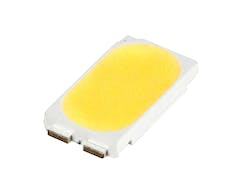Seoul Semiconductor and Everlight trumpet efficacy gains in 5630 LEDs
Mid-power LEDs in 5630 packages from Everlight Electronics and Seoul Semiconductor exceed 200-lm/W performance and target general illumination.
We continue to see technical evolution in the packaged LED space and efficacy advancements have been at the top of the list recently, especially for mid-power LEDs. Seoul Semiconductor has announced that it can deliver 210-lm/W efficacy in the 5630 (5.6×3-mm) footprint for solid-state lighting (SSL) product developers. Likewise, Everlight Electronics said it will show 5630 LEDs at Light+Building (L+B) next week that hit 220 lm/W.
Interested in more articles & announcements on packaged LEDs?
Seoul Semiconductor
The Seoul announcement was focused on the company's multi-junction technology (MJT). Specifically, the announcement centered on the Acrich MJT 5630D+ packaged LED that is intended to be deployed in screw-base replacement lamps, T5/T8 tubes for fluorescent replacement, and other applications. Moreover, Seoul said that the LED family would hit 220 lm/W within a year.
Seoul first revealed the MJT technology in 5630 and other LEDs back in late 2012. The MJT designation implies that there are multiple arrayed emitters integrated in what is traditionally a discrete LED package. Seoul has said that it can connect the arrays using semiconductor processes rather than relying on the bond wires used by some manufacturers in such arrays.
Many companies have such multi-emitter products with one of the advantages being to connect the emitters in series to raise the forward voltage closer to AC line levels, making for a more efficient power conversion. Seoul also favors the high forward voltage for pairing with the company's Acrich AC-LED driver technology.
Seoul made the efficacy milestone announcement relative to the roadmap that the US Department of Energy (DOE) has published in its "Solid-State Lighting R&D Plan." The DOE has called for 220-lm/W LEDs by 2020, but clearly Seoul and others will achieve that goal sooner.
Of course, the significance of maximum efficacy announcements is invariably tough to judge. Seoul did not specify details such as temperature, drive current, or CCT at which the milestone has been reached. And all of those factors impact efficacy. Still, progress — especially in mid-power devices — is abundantly clear.
Everlight Electronics
Indeed, Everlight said it has already achieved the 220-lm/W goal set by the DOE. Everlight did say that its achievement was based on a rather cool 5000K-CCT packaged LED. Efficacy for a 2700K-CCT LED would clearly be significantly lower. Note that the DOE has also called on LED makers to close the efficacy gap between cool and warm CCTs, and progress is being made.
The 5630 HE KK7D-ELB packaged LED in the Everlight case was operated at 0.2W, which would indicate a drive current in the 66-mA range. The HE designation in the model number refers to High Efficiency. Everlight said it can supply the LEDs with color consistency within 3 MacAdam ellipse bins.
The KK7D packaged LEDs follow the prior 195-lm/W KK5D and 205-lm/W KK6D families. The KK6D families were just said by the company to be in volume production at the end of 2015.
Everlight says the new LEDs use thermal plastic materials with high reflectivity and long lifetime. Moreover, the LEDs can be dropped into existing designs that use prior 5630 LEDs from the company. Everlight said a 2000-lm linear fixture would only require 12W to power the needed LEDs and said that figure represented a 30–40% improvement relative to the company's prior products.

Maury Wright | Editor in Chief
Maury Wright is an electronics engineer turned technology journalist, who has focused specifically on the LED & Lighting industry for the past decade. Wright first wrote for LEDs Magazine as a contractor in 2010, and took over as Editor-in-Chief in 2012. He has broad experience in technology areas ranging from microprocessors to digital media to wireless networks that he gained over 30 years in the trade press. Wright has experience running global editorial operations, such as during his tenure as worldwide editorial director of EDN Magazine, and has been instrumental in launching publication websites going back to the earliest days of the Internet. Wright has won numerous industry awards, including multiple ASBPE national awards for B2B journalism excellence, and has received finalist recognition for LEDs Magazine in the FOLIO Eddie Awards. He received a BS in electrical engineering from Auburn University.






